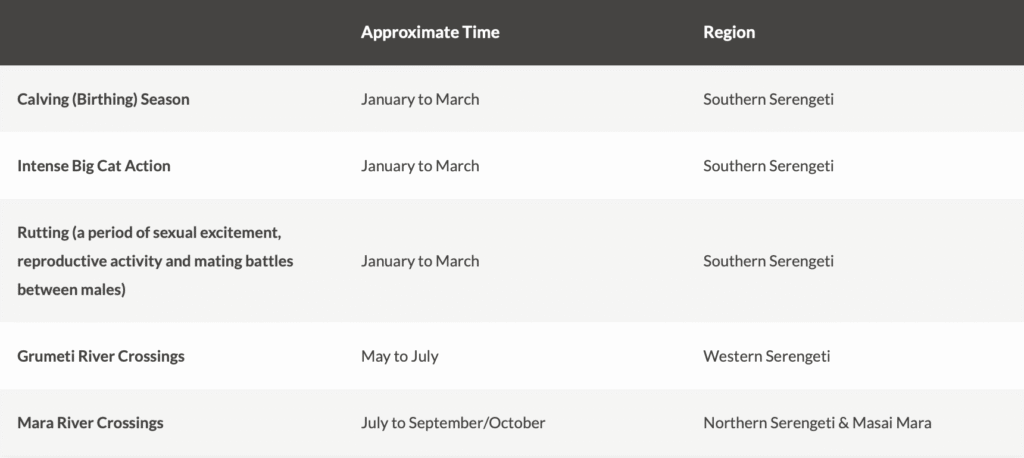Wildebeest Migration Safari Travel Advice
Witness the Greatest Wildlife Show on Earth in Kenya & Tanzania
Travel Advice: A Wildebeest Migration Safari
The Great Wildebeest Migration is one of nature’s most awe-inspiring spectacles—an ancient cycle driven by seasonal rainfall and the search for fresh grazing across the Serengeti-Mara Ecosystem. As nearly 2 million wildebeest, zebra, and gazelle move in rhythm with the rains, they navigate vast plains, treacherous river crossings, and predator-laden terrain.
Because the Migration’s timing and location shift each year, depending on rainfall patterns, planning a successful Wildebeest Migration safari requires deep local expertise and timely insights. Knowing when and where to go—whether it’s the calving season in southern Serengeti or the dramatic river crossings in Kenya’s Masai Mara—can make all the difference between missing the herds or witnessing nature at its most raw and unforgettable.
When To Go On A Wildebeest Migration Safari
The Migration takes a full year to complete a single cycle, which means that you can witness different stages throughout the year. But because the animals cover huge distances, certain highlights only happen in specific months:

Please note: The Wildebeest Migration is a year-round natural event, and while general patterns exist, the exact timing of the river crossings is unpredictable. These dramatic crossings typically occur between May and September, but nature doesn’t follow a fixed schedule.
Some days, the herds may remain on one side of the river for weeks at a time, while on others, they may cross back and forth multiple times in a single day. Flexibility, local knowledge, and expert guidance are essential for maximizing your chances of witnessing this once-in-a-lifetime spectacle.
How To Book Your Wildebeest Migration Safari
Since 1998, Makali Safaris has helped thousands of travelers witness the Great Wildebeest Migration—a natural phenomenon that remains one of the most awe-inspiring wildlife spectacles on Earth. Based on our extensive first-hand experience and local insight, here are our top recommendations to help you plan the ultimate Wildebeest Migration safari in East Africa:
1. Choose the Right Place at the Right Time
The Wildebeest Migration is a dynamic, ever-shifting journey influenced by seasonal rains. To make the most of your safari, it’s crucial to understand where the herds are likely to be each month and what stage of the migration you want to witness—whether it’s calving season in the southern Serengeti or river crossings in the Masai Mara.
2. Getting There
The Masai Mara is accessible by road or scheduled flights from Nairobi and pairs well with other Kenyan parks. The Serengeti is best reached via a flight from Arusha Airport, near Kilimanjaro International Airport. Most travelers overnight in Arusha before flying into the Serengeti, allowing for seamless connections with other top destinations like Ngorongoro Crater or Tarangire.
3. Avoid the Crowds
During peak season (June to October), the Masai Mara National Reserve and Serengeti National Park can become crowded. For a more exclusive safari experience, consider staying in private conservancies bordering the Masai Mara. These offer added benefits like off-road game drives, night safaris, and guided bush walks, not permitted inside the main reserve.
In the Serengeti, opt for camps located just outside high-traffic areas. These still provide access to Migration hotspots but also offer a peaceful retreat.
4. Book Early
Great Migration safaris sell out fast—especially for camps near river crossing points or prime wildlife-viewing zones. We recommend booking 12 months in advance to secure the best lodges, guides, and itineraries.
5. Add More to Your Itinerary
The Masai Mara and Serengeti combine beautifully with other East African highlights. Pair the Masai Mara with Amboseli and Laikipia, or expand a Serengeti safari with Ngorongoro Crater, Tarangire, and the Rift Valley Lakes. This adds diversity to your experience and helps you discover the region’s full ecological richness.
6. Diversify Your Game Viewing
Migration safaris can be intense—with massive herds, roaring predators, and packed viewing vehicles. For balance, we recommend ending your trip at a quieter lodge away from the main Migration routes. This allows you to relax and enjoy a more tranquil, Big 5-focused safari experience.
Planning a Wildebeest Migration safari takes careful timing and insider knowledge—but the rewards are unforgettable. Let Makali Safaris craft a journey that gets you close to the action while ensuring comfort, exclusivity, and a full appreciation of East Africa’s spectacular wilderness.





